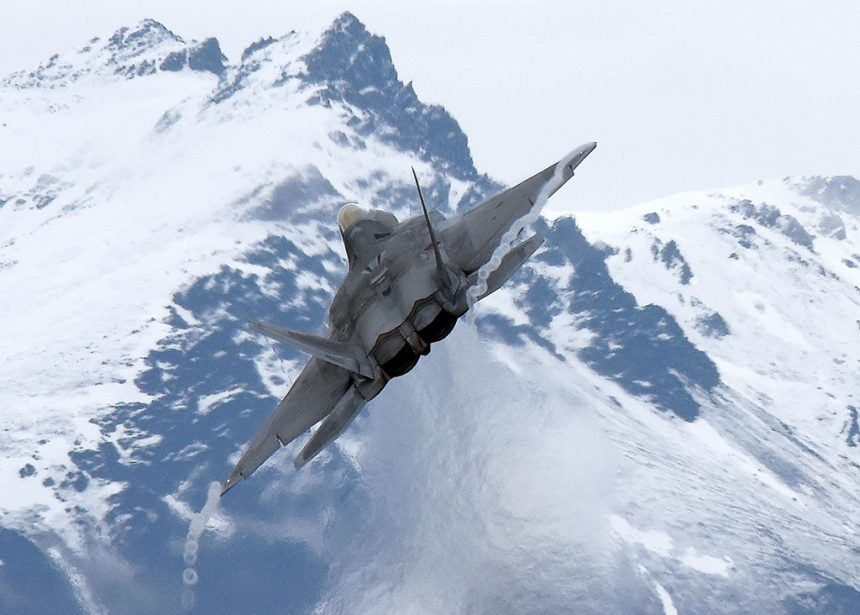Let’s have a look at what happened in the airspace off Alaska a couple of weeks ago.
On the night of May 3, 2017, two Russian nuclear-capable Tu-95MS Bear bombers, this time escorted by two Su-35S Flanker-E jets, flew again inside the Alaskan ADIZ (Air Defense Identification Zone).
The “mini” package was intercepted by two U.S. Air Force F-22 Raptors some 50 NM to the south of Chariot, Alaska.
The Su-35 is a 4++ generation aircraft characterized by supermaneuverability. Although it’s not stealth, it is equipped with a Irbis-E PESA (Passive Electronically-Scanned Array) and a long-range IRST – Infrared Search and Tracking – system capable, (according to Russian sources…) to detect stealth planes like the F-35 at a distance of over 90 kilometers.
The Su-35S was deployed at Hmeymim airbase, near Latakia in Syria at the beginning of 2016, to provide cover to the Russian warplanes conducting raids in Syria in the aftermath of the downing of a Su-24 Fencer by a Turkish Air Force F-16. During the Syrian air war the aircraft carried Vympel R-77 medium range, active radar homing air-to-air missile system (a weapon that can be considered the Russian counterpart of the American AIM-120 AMRAAM) along with R-27T (AA-10 Alamo-B), IR-guided air-to-air missiles (however, the Flanker E jets escorting the Tu-95s off Alaska, did not carry any weapon.)
Shortly after being deployed to Syria the Su-35S started shadowing US-led coalition aircraft: a German Air Force spokesperson explained that the Russian Flankers were among the aircraft used by the Russian Air Force to shadow the GAF Tornado jets carrying out reconnaissance missions against ISIS; a VFA-131 video that included footage from the cruise aboard USS Eisenhower in support of Operation Inherent Resolve, in Syria and Iraq showed a close encounter with what looked like a Su-35S Flanker-E filmed by the Hornet’s AN/ASQ-228 Advanced Targeting Forward-Looking Infrared (ATFLIR) pod.
Although we have no confirmed reports of “close encounters” between the F-22 and the Flanker in the skies over Syria, what makes May 3 episode particularly interesting is the fact that this was the first time the U.S. Air force Raptors saw the Su-35S near the U.S. coasts.
Moreover, it’s worth noticing the “readiness in flight” posture of the stealth fighters.
Indeed, according to USAF, the Raptors were “committed” by North American Aerospace Defense Command to intercept the Russian aircraft while already in air patrol not too far away. It’s not clear whether the F-22s were already flying because involved in “Northern Edge”, Alaska’s largest and premier joint training exercise with MOB (Main Operating Base) at Joint Base Elmendorf-Richardson, or the CAP (Combat Air Patrol) was one of the measures introduced to enhance the readiness of the U.S. Air Force Air Defense assets as a consequence of the “unprecedented level activity of Russian bombers” recorded in the last months.
Anyway, the American premiere stealth fighters were already flying and thus could be quickly diverted by NORAD to “greet” the Russian package, this time supported by an A-50 Mainstay surveillance plane from distance.
The presence of Mainstay and Flanker confirms what this Author has already explained in the previous report about the key factors to take in consideration when planning a long-range strike sortie.
In my opinion the “mini package” was launched as a consequence of the increased flight activity in Alaska related to the Northern Edge exercise, confirming that the Russians closely observe what happens in the Alaskan area.
This time, they wanted to showcase their ability to plan a complex long-range sortie as well as the Flanker’s readiness to escort its own HVA (high value asset), the Bear, during operations at strategic distance.
The composition of this package is also worth a comment.
The presence of the Mainstay should not be underestimated. It was flying well behind the Flanker and Bear aircraft with a specific purpose. As an AEW (Airborne Early Warning) platform the A-50 is believed to embed some ESM (Electronic Support Measures): in other words, it is able to detect far away targets as well as able to sniff radar, radio and data link emissions. Furthermore, Raptors in QRA (Quick Reaction Alert) *usually* fly with external fuel tanks and Luneburg lenses: this means that they are (consciously) visible to radars. In such conditions, although it can’t “characterize” the clean F-22’s signature, the Mainstay can at least gather some data about the interceptors’ radar emissions (if any) and observe and study their tactics.
Therefore, as frequently happens on both sides since the Cold War, on May 3, the Russians most probably carried out another simulated long-range strike mission but with a precise ELINT (ELectronics INTelligence) objective: the Flankers and Bears were acting as a “decoy” package to test the American scramble tactics and reaction times, whereas the Mainstay, in a back position, tried to collect as much signals and data as possible about the US fighters launched to intercept them.









